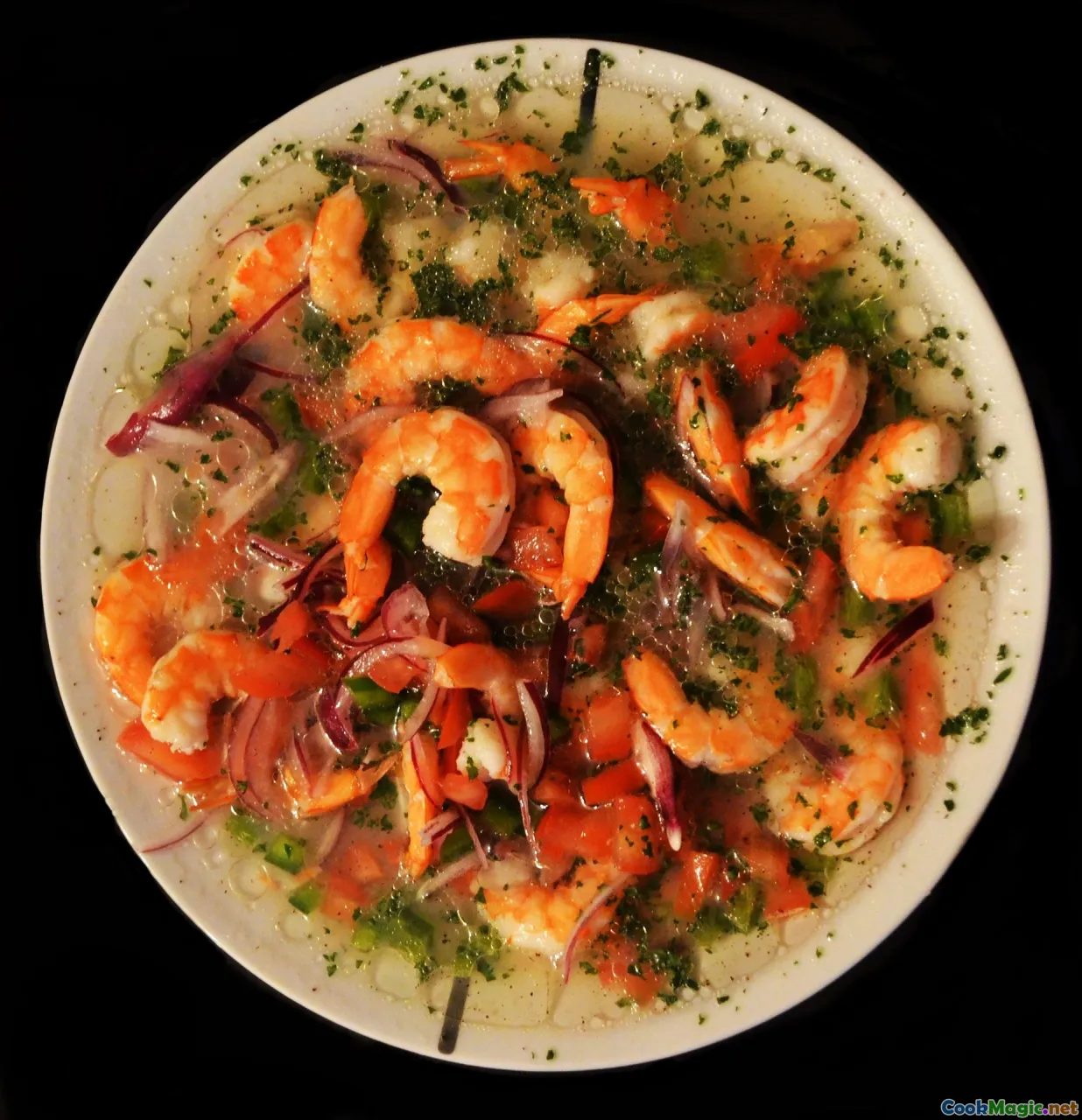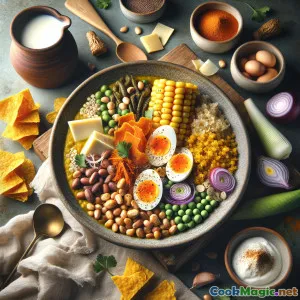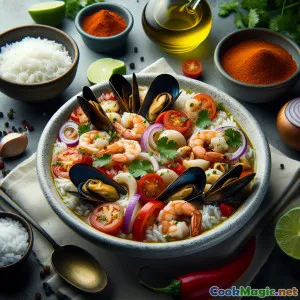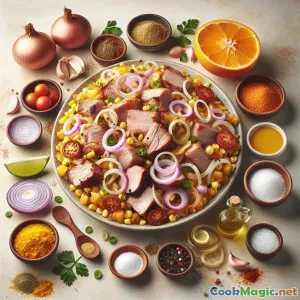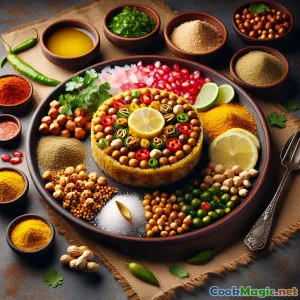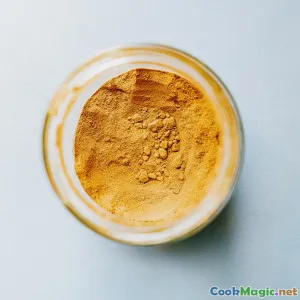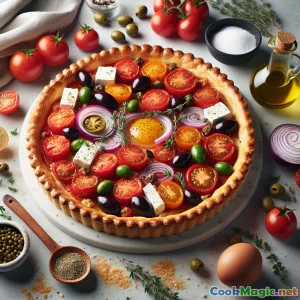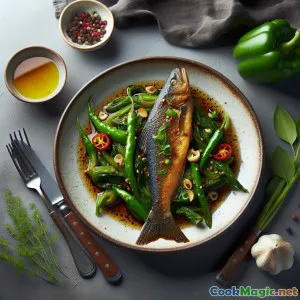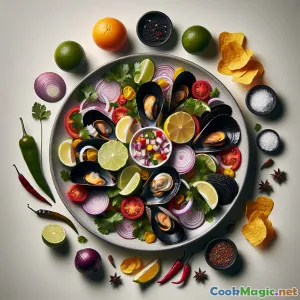
Ceviche Tôm Đầu Rồng Đen Esmeraldeño
(Tangy Black Clam Ceviche Esmeraldeño Style)
(0 Đánh giá)0
692
tháng 7 16, 2025
Báo cáo sự cố
Nguyên liệu
-
500 grams Concha đen (Black clams)
(Tươi, đã chà sạch, vỏ đã được loại bỏ)
-
1 medium Hành tím
(Cắt mỏng)
-
8 whole Chanh tươi
(Chỉ nước ép tươi, ép mới)
-
60 ml Nước cam
(Tươi, không từ nước ép cô đặc, có thể thêm vỏ chanh để trang trí (tùy chọn).)
-
1/3 cup Ngò rí
(Băm nhỏ)
-
1 medium Cà chua
(Cắt nhỏ mịn)
-
1 whole Ớt cay (ají hoặc Serrano)
(Băm nhuyễn mịn, tùy mức độ chịu cay có thể bỏ qua.)
-
1 tsp Muối
(Điều chỉnh theo khẩu vị)
-
1/2 tsp Hạt tiêu đen
-
1/4 tsp Hạt thì là
(Tùy chọn, để tạo hương thơm đích thực.)
-
30 grams Bắp rang nướng (chifles hoặc ngô nướng)
(Để trang trí và giòn)
-
40 grams Khoai mì lát giòn
(Tùy chọn, để trang trí)
(Tươi, đã chà sạch, vỏ đã được loại bỏ)
(Cắt mỏng)
(Chỉ nước ép tươi, ép mới)
(Tươi, không từ nước ép cô đặc, có thể thêm vỏ chanh để trang trí (tùy chọn).)
(Băm nhỏ)
(Cắt nhỏ mịn)
(Băm nhuyễn mịn, tùy mức độ chịu cay có thể bỏ qua.)
(Điều chỉnh theo khẩu vị)
(Tùy chọn, để tạo hương thơm đích thực.)
(Để trang trí và giòn)
(Tùy chọn, để trang trí)
Dinh dưỡng
- Khẩu phần: 4
- Kích thước khẩu phần: 1 bát (250g)
- Calories: 220 kcal
- Carbohydrates: 23 g
- Protein: 17 g
- Fat: 3 g
- Fiber: 4 g
- Sugar: 6 g
- Sodium: 650 mg
- Cholesterol: 75 mg
- Calcium: 100 mg
- Iron: 6 mg
Hướng dẫn
-
1 - Làm sạch và chuẩn bị nghêu:
Rửa sạch nghêu đen dưới nước lạnh hoàn toàn. Dùng bàn chải mềm chà sạch vỏ nếu cần. Mở nghêu và cho thịt vào rổ lọc, nhẹ nhàng rửa sạch cát còn lại.
-
2 - Ngâm hành:
Ngâm hành tím đỏ lát mỏng trong nước đá 5 phút để làm dịu vị. Vắt ráo trước khi dùng.
-
3 - Hỗn hợp nền cho ceviche:
Đặt thịt nghêu sạch vào một bát không phản ứng. Thêm nước cốt chanh, nước ép cam (nếu dùng), muối, tiêu và thì là. Khuấy nhẹ nhàng.
-
4 - Thêm rau củ và hương vị:
Nhẹ nhàng trộn ngò rí, hành tây ngâm, ớt ají băm (nếu thích) và cà chua. Trộn cho đến khi hòa quyện.
-
5 - Ướp ceviche:
Đậy kín bát và cho vào tủ lạnh 8–15 phút, để nước chanh cam quýt làm 'chín' nghêu sò và hương vị hòa quyện.
-
6 - Phục vụ và Trang trí:
Dọn lạnh trong các bát nhỏ. Hoàn thiện bằng rau mùi tươi, ngô rang và lát chuối sáp chiên ở bên theo ý thích.
Rửa sạch nghêu đen dưới nước lạnh hoàn toàn. Dùng bàn chải mềm chà sạch vỏ nếu cần. Mở nghêu và cho thịt vào rổ lọc, nhẹ nhàng rửa sạch cát còn lại.
Ngâm hành tím đỏ lát mỏng trong nước đá 5 phút để làm dịu vị. Vắt ráo trước khi dùng.
Đặt thịt nghêu sạch vào một bát không phản ứng. Thêm nước cốt chanh, nước ép cam (nếu dùng), muối, tiêu và thì là. Khuấy nhẹ nhàng.
Nhẹ nhàng trộn ngò rí, hành tây ngâm, ớt ají băm (nếu thích) và cà chua. Trộn cho đến khi hòa quyện.
Đậy kín bát và cho vào tủ lạnh 8–15 phút, để nước chanh cam quýt làm 'chín' nghêu sò và hương vị hòa quyện.
Dọn lạnh trong các bát nhỏ. Hoàn thiện bằng rau mùi tươi, ngô rang và lát chuối sáp chiên ở bên theo ý thích.
Thông tin thêm về: Ceviche Tôm Đầu Rồng Đen Esmeraldeño
Ceviche de Concha Negra Esmeraldeño: History, Culture, and Culinary Insights
Ceviche de Concha Negra Esmeraldeño is one of Ecuador’s most coveted coastal delicacies, steeped in traditions and abounding with regional influences. Originating from the northern province of Esmeraldas—an area famed for its Afro-Ecuadorian heritage and vibrant seafood fare—this ceviche diverges strikingly from its better-known cousins made with white fish or shrimp. Esmeraldas sits right along Ecuador's balmy Pacific Ocean, making fresh shellfish an immense part of the local diet.
Unique and Bold Main Ingredient
Concha negra, or black clam (Anadara tuberculosa), is distinguished by an almost inky color, robust briny flavor, and more intense savoriness compared to typical ceviche ingredients. Black clam also lends a deeper, slightly mystical color to the marinating liquid—often resulting in a purplish or jet-black consommé prized as both a delicacy and a restorative tonic. There's even a cultural belief among many locals that ceviche de concha negra is an aphrodisiac and provides a potent boost of energy.
Cultural Significance and Regional Atmosphere
The city of Esmeraldas, with its dynamic, African-Ecuadorian energy, hosts what can best be described as sensory culinary rituals. Vendors serve this ceviche piping fresh, regal in bright orange limes and lush green cilantro, at seaside markets, roadside stalls, and family homes for weekend indulgence or recados (celebrations). It’s a dish tied intimately to communal gatherings, symbolizing the abundance of the sea and the resourcefulness of coastal dwellers.
Preparation & Traditional Serving
Preparing this ceviche is both art and celebration: the clams must be fresh—often still pulsating with saline ‘life’—cleaned meticulously, and only momentarily marinated so their supple texture and natural juice remain vivid. Macerating the onions beforehand is not just a flavor technique; it’s about ensuring the layering of tastes and making the dish more palatable and refreshing on hot coastal days. The addition of orange juice isn’t strictly canonical but often used for extra sweetness or for times when limes are exceptionally tart.
Esmeraldeños frequently finish the dish with crunchy corn kernels (‘maíz tostado’) and crisp plantain chips, which provide flavor contrast and textural interest, all eaten preferably while watching the Pacific waves.
Unique Aspects & Tips
- Clam Freshness: Only use the freshest black clams you can get—texture and brininess start to diminish within hours.
- Citrus Marination: Unlike fish-based ceviches, you want the ‘cooking’ time very brief in order to preserve the clam’s soft, yielding bite.
- Optional Additions: Locals might stir in a teaspoon of cold clam broth to heighten the flavor—if your shellfish is top quality, collect and strain it!
- Herbage and Heat: While aji tends to be optional (spice tolerance in Ecuador varies regionally), a gentle sprinkle offers a wonderful kick without overshadowing the sweet-plump seafood.
Modern Enjoyment – Sustainable and Accessible
Due to overfishing and regulations on black clam harvest, availability varies, yet the dish persists as a beloved regional identity marker. For home cooks outside South America, frozen black clam meat (often from specialized Latin food markets) can offer a close approximation.
What Stands Out Most?
- The unusual color and strong ocean flavor—unmistakably different from lemony fish ceviches.
- Its symbolism as festive and even slightly “forbidden” sea magic from Ecuador’s northern shores.
Final Thoughts
To taste Ceviche de Concha Negra Esmeraldeño is to bite into the very essence of Ecuador’s glorious Pacific coast—salty breezes, warm hospitality, drums and marimbas echoing in the background, and the flavor of tradition that links past and future generations. This recipe not only delights, but feeds the adventurous soul with cultural adventure, uniqueness, and soul.



